I’m proud to be working with Idaho® Potatoes to bring you this recipe for Soft Sandwich Buns.
I think you will really love this soft potato rolls recipe I made in partnership with my friends from Idaho Potatoes. Because homemade potato rolls are the best.
Using potato in bread recipes keeps them fresher longer, and they bake up really soft and perfect as the base for building sandwiches.
If you’re a fan of potato bread, you may also enjoy my soft potato sandwich bread recipe, too.
For ease of browsing, you can find all my bread and roll recipes in one place. Thanks so much for visiting!
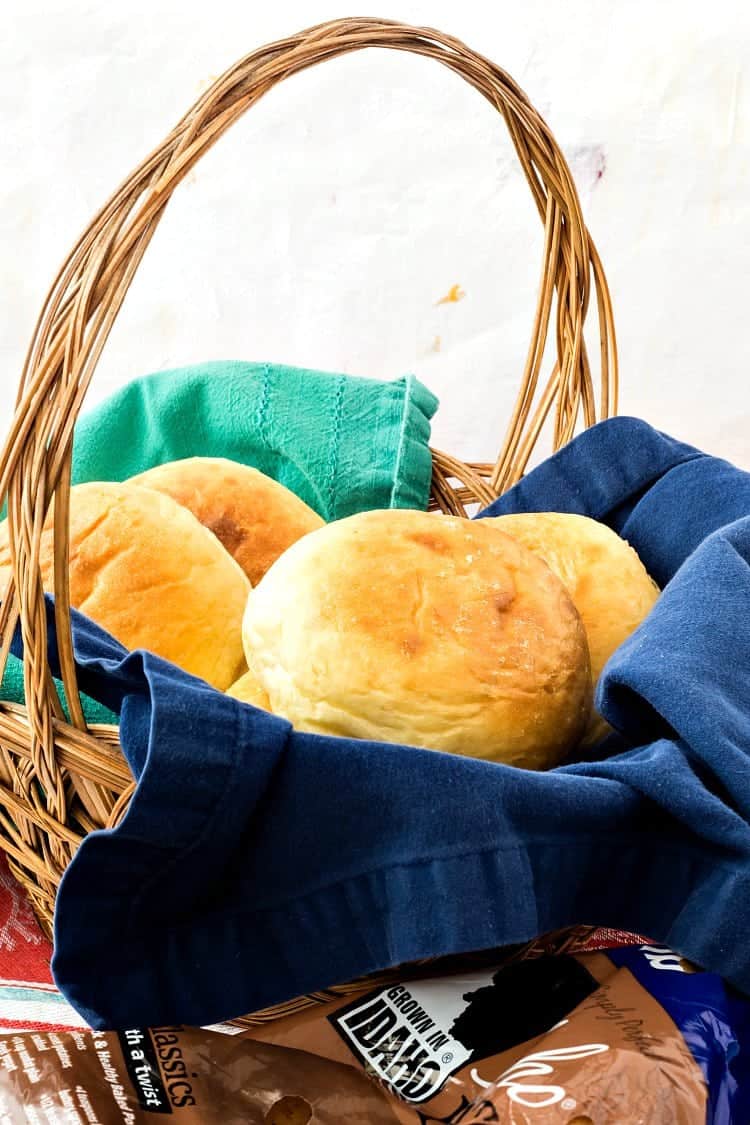
These rolls have perfect texture and taste. Extremely happy with the results!
REader Angela
Why Make This Recipe?
I love a good, hearty grain bread. Shove as many seeds and nuts and whatnot into a crusty loaf, and I’m a happy girl.
But man. Sometimes you just want a soft roll. One that has great flavor, but that is content to take a back seat to whatever you choose to put on it.
Pastry Chef Online Participates in Affiliate Programs. If you make a purchase through one of my links, I may earn a small commission. For more information click to read my disclosure policy
A bread that sort of squishes when you bite into it, but one that can stand up to some hearty toppings, you know?
Like potato bread. Like these soft sandwich buns that I made with Idaho® Potatoes.
Why Are Potato Rolls So Soft?
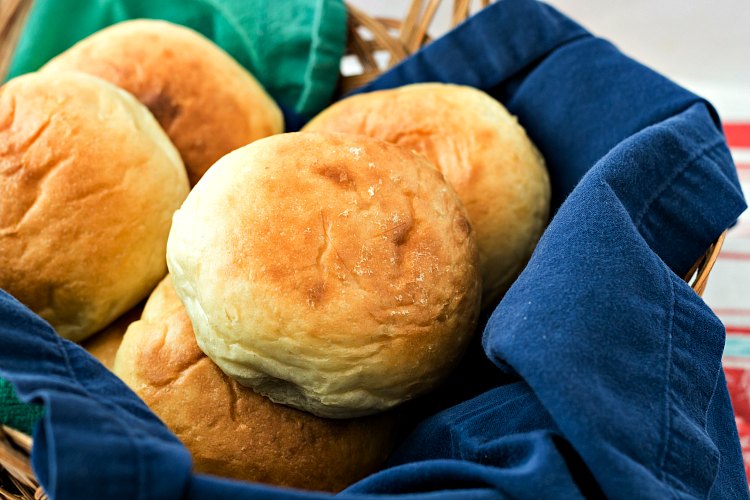
I have been giving this question a lot of thought recently. And this is the conclusion I’ve come to.
Keep in mind I don’t necessarily have scientific data to back me up–this is conjecture, but it’s conjecture based on what I know about how ingredients function and interact.
Here’s what I’m thinking. Using mashed potatoes in a bread is sort of a shortcut method for making bread using the Tangzhong method.
In the Tangzhong method, you take a portion of the flour out of the recipe, mix it with a portion of the water, and heat that together, stirring, until you end up with a thick, almost mashed potato-like, paste.
Once it cools off, you then add that mixture back into the dough.
What you’re doing is pre-gelatinizing some of the starches in the flour, binding up the gluten in that portion of flour so it doesn’t add to chewiness.
The gelatinized starches hold onto water, keeping the resulting bread soft, springy, and moist for several days.
Boiling the potatoes to add to the dough yields similar results: a soft, springy bread that squishes nicely and stays moist for days. In Tangzhong, you usually take about 10% of the total weight of the flour and mix it with five times that amount of the liquid called for.
Why Using Potatoes Might Be Even Better Than Tangzhong: Some Math
For simplicity’s sake, let’s say your recipe calls for 20 oz of flour.
To make Tangzhong, you’d use about 2 oz of the flour and cook it with 10 oz (5 x 2) of the liquid called for.
With potato bread, and specifically in this recipe for soft sandwich buns, I used 8 oz of mashed potato and 16 oz of flour.
Rather than reducing available gluten by roughly 10% with Tangzhong, you end up reducing it by about 33% using potatoes (gluten from 24 oz of flour is replaced by gluten in 16 oz of flour and the 8 oz of potatoes).
Would you like to save this post?
That’s why your bread ends up being super tender and soft while still retaining some chew. Thank you, potatoes, for being so awesome!
Boom!
Ingredients You’ll Need
- potatoes: Use a starchy rather than waxy potato. My preference is Russet, but you could also use Yukon Golds if that’s what you have on hand. Do not use red potatoes–they are better suited to German potato salad since they hold their shape (NOTE: You won’t use all your mashed potato in this recipe, so have a Plan B for the leftovers)
- cold water: For cooking the potatoes
- kosher salt: You’ll use this twice. First in the cooking water to season the potatoes themselves and then again in the dough. I use Morton’s. If you use Diamond Crystal, you’ll need to up the amount by about 1/3. If using fine salt, use about half the amount called for
- butter: I use unsalted. Use stick butter rather than “tub” butter which generally has additional oils and some extra water in it to make it spreadable straight from the fridge
- milk: This is the liquid in the dough as well as what you’ll brush onto the rolls before baking. The milk adds some sweetness in the form of lactose (milk sugars), some protein, and assists in browning. It also keeps the crust nice and soft. I use whole milk. You may substitute 2%, but please don’t use skim. At that point, you may as well must use water.
- sugar: lends of touch of sweetness, helps to tenderize the crumb, and assists in keeping qualities (adds moisture) and browning. You may substitute honey if you prefer. If so, cut back on the milk in the recipe by a tablespoon or so.
- eggs: adds protein and fat as well as liquid for making the dough. The fats help enrich the bread, lend a pale, buttery color to the crumb, assist in browning, and carry the flavor.
- egg yolk: Adds a touch of additional color and richness while the emulsifiers in the yolk help to make a uniform dough
- bread flour: You really do need the bread flour for structure since there is so much potato in the dough. I recommend King Arthur or another “premium” brand of high protein flour
- yeast: You may use instant or active dry yeast. If using active dry and you’re unsure if it’s still alive. Proof it in the milk
Soft Potato Rolls Q & A
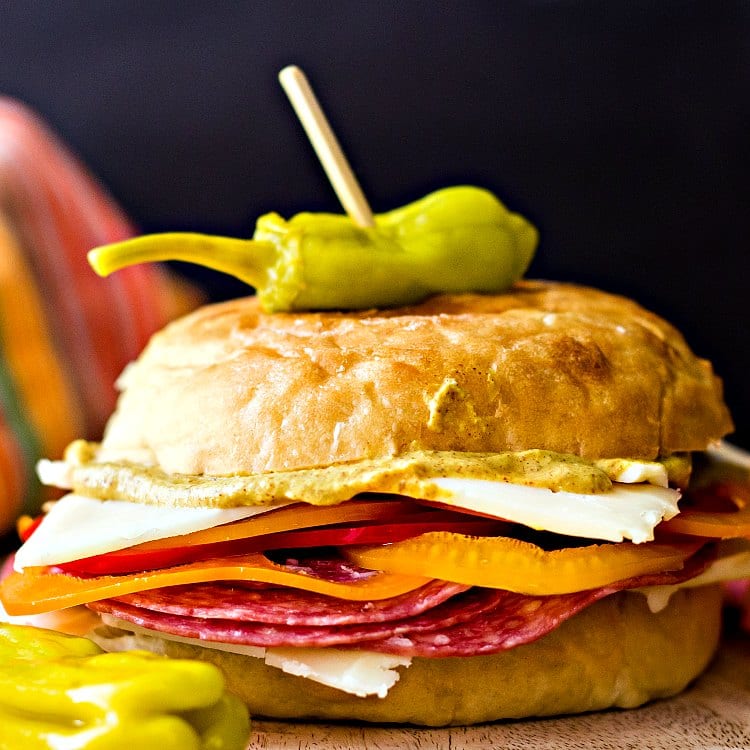
Here are some frequently asked questions about making and storing homemade rolls. I hope you find this helpful!
No. Waxy potatoes don’t have the right sort of starch structure to hold onto the moisture, and they also like to hold their shape which makes it harder to mash them for adding to the dough. Stick to Idaho russets for best results.
My preference is usually active dry yeast, although you can use either active dry or instant yeast. If you use active dry yeast, let it bubble in a portion of the liquid from the recipe before adding the rest of the ingredients. If you use instant yeast, you can just put everything in your mixer at once.
This recipe requires 2 rises. The first will take about 2 hours. The second, which happens once you shape the rolls, is about 45 minutes. Since the dough is so soft, I also suggest you refrigerate it for about an hour after the first rise and before you shape the buns for the second rise.
Yes you can. Scale out 2 ounce portions of dough rather than 3. The recipe will yield about 18 dinner rolls. If you want even larger sandwich buns, scale at 4 oz rather than 3. You’ll end up with 9 larger buns. As written, you’ll end up with 12 3 oz rolls.
Absolutely. Almost all breads freeze really well. If you’re not going to eat all your rolls within 2-3 days, cool them completely then store them in freezer bags, pressing out as much air as you can before sealing. They’ll be just fine for about a month.
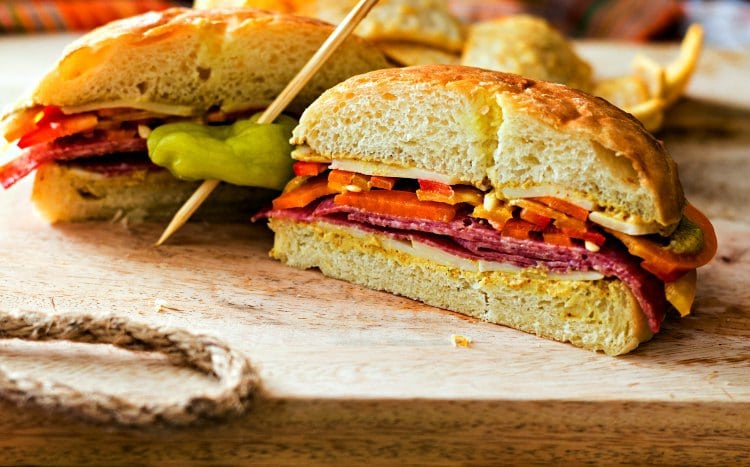
Serving Suggestions
Use these rolls as the base for your favorite sandwiches. Individual muffaletta sandwiches would work great on these soft buns.
And don’t discount the deliciousness of a squishy bun when you make your next batch of smashed bacon cheeseburgers.
Use them instead of English muffins as the base of your breakfast sandwiches. And don’t forget to use some bacon jam or plum chutney as a sweet-savory spread to go with fried eggs and cheese.
Brush them with some egg wash, dip them in everything bagel seasoning, dried onion, sesame seeds, etc.
You can even do this after they’re baked! Brush on some egg wash or just some egg white as “glue.” Dip in seeds and then bake until your glue is dry, about 5 minutes or so at 350F.
Don't let its small price and small size fool you. The Escali Primo is an accurate and easy-to-use food scale that I have used for years. It's easy to store, easy to use, has a tare function, and easily switches between grams and ounces/pounds for accurate measurements.
It will help me and other readers so much if you take a moment to rate and leave a review for this recipe.
You can use the stars to rate 1-5 (5 is best), and leave a review in the comments. It helps me make adjustments if any are needed, and comments help others decide whether the recipe is worth making.
Other ways to share include pinning, and/or sharing on your favorite social media platform.
Thank you so much for taking the time!

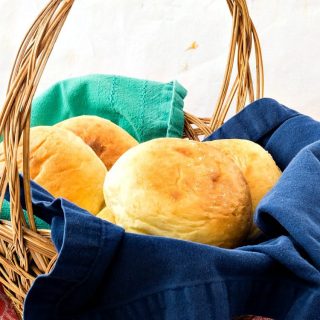
Soft Sandwich Rolls (Homemade Potato Rolls)
Would you like to save this post?
Equipment
Ingredients
- 2 medium IdahoⓇ potatoes , peeled and cut into 1” chunks
- Cold water to cover
- 2 teaspoons kosher salt
- 2 ounces unsalted butter (½ stick)
- 6 ounces whole milk
- 3 tablespoons granulated sugar
- 1 large egg
- 1 large egg yolk
- 1 ½ teaspoons kosher salt
- 1 pound higher protein bread flour (such as King Arthur)
- 1 tablespoon active dry yeast
- ¼ cup whole milk for brushing before baking
Instructions
- Place the potatoes in a medium saucepan, and cover with water by about 1". Add 2 teaspoons kosher salt to the water.
- Bring potatoes to a boil and then simmer for 10-12 minutes or until they offer no resistance when pierced with a knife.
- Drain the water out of the pan. Put the lid on the pan and put the pan back on the burner (now turned off) for about 5 minutes. This will help the potatoes to dry. When ready, they will look a little "floury" on the outsides. If you have a stove whose burners do not retain heat (such as a gas stove), put over a very low flame to dry.
- Weigh out 8 oz of the potatoes (about 1 cup, lightly packed), and put them in the bowl of your stand mixer. Fit the mixer with the paddle attachment and mix until smooth.
- Cut the butter into 4-5 pieces and add to the mixer. Mix until the butter has melted.
- Mix in milk, sugar, egg, egg yolks, and salt until you have what looks like potato soup.
- Add the flour to the bowl, and top with the yeast. Switch to the dough hook, and mix on low speed until the dough comes together, about 2-3 minutes.
- Increase the speed to medium and knead until the dough is smooth, shiny, and supple, about 7-8 minutes.
- Once the dough is shiny and stretchy, gather it into a ball. The dough will be fairly soft, so do the best you can.
- Place the dough into a large, buttered or pan-sprayed bowl, spray the top with pan spray, and cover with a lint free kitchen towel or with plastic wrap.
- Let rise in a warm place until doubled in volume, about 2 hours.
- Spray a half sheet pan with pan spray and have it nearby.
- Turn out dough onto a clean, smooth surface. Gently press out the gases from the dough.
- Using your bench knife and scale, divide your dough into 12 3 ounce portions.*
- Place these on your baking pan, cover with plastic wrap, and refrigerate for an hour.**
- Meanwhile, prepare your work surface by dusting lightly with flour. Have a cup or so of extra flour handy as well.
- Line 2 baking sheets with parchment paper, place racks in the top and bottom thirds of your oven, and heat the oven to 375°F.
- Working with one piece of dough at a time, flatten dough out into a disc. Gather up all the edges of the disc and bring them to the center. Turn the dough so the smooth side is up, and add a sprinkle of flour to make it easier to work with.
- Use your cupped hands to roll the ball on the counter, pulling the skin of the ball taut.
- Place on one of the prepared pans.
- Continue working in this way, adding a bit of flour as needed and placing 6 rolls on each of the pans.
- Spray the tops lightly with pan spray, cover with plastic wrap, and let rise in a warm place until puffy, about 45 minutes.
- When rolls are nice and puffy, gently brush them with milk. Put in the oven, and bake for 8 minutes.
- Rotate the pans and switch rack positions. Continue baking for an additional 8-9 minutes, or until the rolls are a lovely medium golden brown.
- Allow to cool on the pans for 10 minutes and then transfer to cooling racks to cool completely.
- Buns will be extremely light and puffy once baked. As they cool, they will sink just a bit, and their tops may wrinkle a little. This is normal, and your rolls will end up tender yet chewy with a nice, even crumb.
- Store at room temperature, well covered, for 3-4 days. For longer storage, place in freezer bags, pressing out as much air as possible, and freeze for up to a month.
Did You Make Any Changes?
Notes
Nutrition
And there you have it. homemade potato rolls that squish like kid bread but are chewy and sturdy to stand up to a Dagwood or a burger.
I hope you enjoy them as much as we did. And please check out my recipe page on the Idaho® Potatoes site for all my recipes featuring Idaho® Potatoes!
Thank you for spending some time with me today. Take care, and have a lovely day.

Hi, y’all! I hope you’ve enjoyed this post and hopefully also learned a thing or two.
If you like my style, I invite you to sign up for my occasional newsletter, The Inbox Pastry Chef.
Expect updates on new and tasty recipes as well as a bit of behind-the-scenes action. I hope to see you there!



Join in Today!
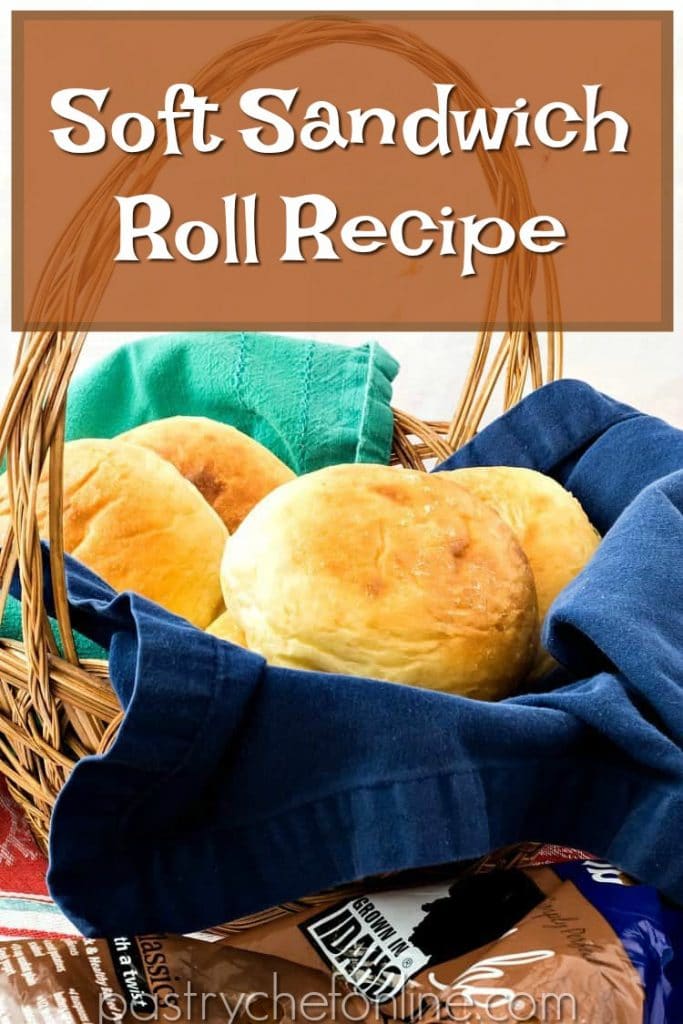


These rolls have perfect texture and taste. Extremely happy with the results!
Hi Jenni, thanks for the recipe! My only issue is and maybe it’s just my blind self lol) but I don’t see where to add in the yeast. Please clarify, thanks!
Hey, Lexcee! I am so sorry–it was a typo, so my fault entirely! I’ve updated the recipe to say “top with the yeast,” rather than “top with the salt.” The yeast is the last thing that goes in on top of the flour.
Hope that clarifies things! Enjoy the rolls. 🙂